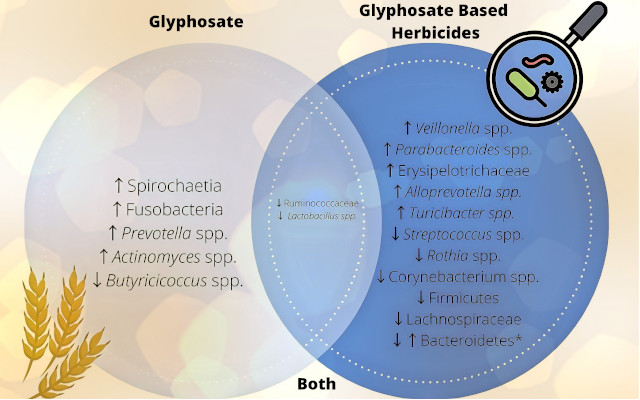Glyphosate, present as a residue in foods, could be the cause of the growing spread of gluten intolerance. The hypothesis is put forward in a scientific review (Barnett et al., 2020) published in Frontiers in Microbiology. (1)
The toxicity of the most widespread agrotoxic in the world is once again relevant in recent days, after the European Commission announced the withdrawal of the SUR (Sustainable Use and Reduction of Pesticides) proposal and the European Parliament approved the deregulation of new GMOs. (2,3)
1) Glyphosate and gluten intolerance, correlations
The researchers of the University of British Columbia wanted to investigate the possible correlations between the increasingly widespread exposure to glyphosate and the growing incidence of both intestinal diseases and gluten intolerance even in the absence of a diagnosis of celiac disease.
The exposure of the general population to glyphosate is also high in the Old Continent, as demonstrated by the study (Grau et al., 2022) which detected its presence in the urine of 99,8% of almost 7.000 residents in 11 regions of France. (4)
Dietary exposure is added to the environmental one (5,6). Glyphosate has in fact been the most widespread herbicide in the world for half a century now, and is also sprinkled on fields as a crop desiccant in the pre-harvest phase, especially in regions where the growing season is short and humid, such as Canada and the United States. first of all, as we have seen. (7)
The triggering mechanism
The toxicity of glyphosate raises concerns about neurotoxic effects, as well as potential cytotoxic and carcinogenic effects emerged both in vivo and in vitro (8,9).
A systematic review – under examination focuses on its effects on the intestinal microbiome – that delicate environment that influences the organism through the gut-brain axis (10) – to demonstrate how glyphosate inhibits the shikimate pathway, a metabolic pathway specific to plants and bacteria. A pathway that is missing in mammals, but is present in the intestinal microbiome thanks to the trillions of microorganisms that live there in a functional ecosystem.
The ‘good’ bacteria they are destroyed by glyphosate which allows the ‘bad’ ones to survive, resulting in intestinal dysbiosis. The condition that favors intestinal pathologies such as celiac disease, inflammatory bowel disease and irritable bowel syndrome. As well as mental disorders, including anxiety and depression.
More studies are needed
The authors of the review scientists also report that ‘Research into glyphosate’s effects on the gut microbiome also suffers from numerous methodological weaknesses, including artificially high doses, insufficient duration, proprietary ingredients, and an over-reliance on animal models.
Future long-term studies are needed that examine physiologically relevant doses in both healthy and genetically predisposed populations to determine the real risk to human health‘.
A strong limit of these studies is also that most of them, for obvious ethical reasons, were conducted on experimental models.
On hold of further studies, consuming only organic foods is the only form of self-defense.
Marta Strinati
On the cover, ‘Summary of alterations in microbial composition reported in the literature during the administration of glyphosate or glyphosate-based herbicides’. Source: Barnett, Gibson (2020), https://doi.org/10.3389/fmicb.2020.556729
Footnotes
(1) Jacqueline A. Barnett, Deanna L. Gibson. Separating the Empirical Wheat From the Pseudoscientific Chaff: A Critical Review of the Literature Surrounding Glyphosate, Dysbiosis and Wheat-Sensitivity. Front. Microbiol., 25 September 2020. Sec. Food Microbiology. Volume 11 – 2020 | https://doi.org/10.3389/fmicb.2020.556729
(2) Dario Dongo, Alessandra Mei. New GMOs, NGTs. Green light from Strasbourg to deregulation. GIFT (Great Italian Food Trade).
(3) Dario Dongo. Protesting farmers, pesticides instead of #fairprice. GIFT (Great Italian Food Trade).
(4) Marta Strinati. Glyphosate in the urine of 99,8% of French people. GIFT (Great Italian Food Trade).
(5) Marta Strinati, Dario Dongo. Pure and ‘100% natural’ with glyphosate? US consumers versus Twinings. GIFT (Great Italian Food Trade).
(6) Marta Strinati. Residues of glyphosate in the pasta, the Balance test. GIFT (Great Italian Food Trade).
(7) Dario Dongo. Glyphosate in wheat and Canadian legumes, all the fault of the snow? GIFT (Great Italian Food Trade). 6.10.19
(8) Dario Dongo. Glyphosate and neurotoxicity, doubts and questions from a toxicologist. GIFT (Great Italian Food Trade).
(9) Van Bruggen, A.H.C., He, M.M., Shin, K., Mai, V., Jeong, K.C., Finckh, M.R., et al. (2018). Environmental and health effects of the herbicideglyphosate. Sci. Total Environ. 616-617, 255–268. doi: 10.1016/j.scitotenv.2017.10.309 https://pubmed.ncbi.nlm.nih.gov/29117584/
(10) Paola Palestini, Dario Dongo. Microbiome and intestine, the second brain. GIFT (Great Italian Food Trade).
Professional journalist since January 1995, he has worked for newspapers (Il Messaggero, Paese Sera, La Stampa) and periodicals (NumeroUno, Il Salvagente). She is the author of journalistic surveys on food, she has published the book "Reading labels to know what we eat".








